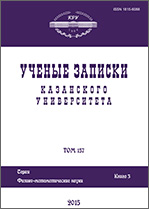|
|
Uchenye Zapiski Kazanskogo Universiteta. Seriya Fiziko-Matematicheskie Nauki, 2017, Volume 159, Book 3, Pages 271–281
(Mi uzku1407)
|
|
|
 |
This article is cited in 3 scientific papers (total in 3 papers)
Estimating the appearance of shock waves in the cavitation bubble during its collapse
A. A. Aganin, D. Yu. Toporkov
Institute of Mechanics and Engineering, Kazan Science Center, Russian Academy of Sciences, Kazan, 420111 Russia
Abstract:
The possibility of appearance of convergent shock waves inside a cavitation bubble during its collapse in acetone and tetradecane has been estimated. The liquid pressure varied from 1 to 100 bar, its temperature changed from 293 K to the values of 419 K for acetone and 663 K for tetradecane, respectively, which are close to the critical ones. With these values, the saturated pressure of vapor of both liquids was equal to 10 bar. The initial radius of the bubble was 500 $\mu$m. A simplified mathematical formulation without taking into account thermal conductivity and evaporation-condensation has been used. The distribution of thermodynamic parameters of vapor in the bubble has been assumed to be homogeneous, the state of vapor has been described by the Van der Waals type equation, the weak compressibility of the liquid at a large distance from the bubble has been taken into consideration. Under these assumptions, the bubble dynamics has been determined by solving the second-order ordinary differential Rayleigh–Plesset equation. The possibility of appearance of a shock wave in the bubble during its collapse has been estimated by a criterion including only the vapor thermodynamic parameters from the bubble boundary and some characteristics of its motion. That criterion also makes it possible to predict the time and place of shock wave formation. The solution to the Rayleigh–Plesset equation has been obtained numerically by the highly accurate Runge–Kutta method. According to the numerical experiments, if the liquid temperature is 293 K, shock waves inside the cavitation bubble arise at the liquid pressures starting from 5 bar in the case of acetone or appear in the entire investigated range in the case of tetradecane. At the acetone temperature of 419 K and the tetradecane temperature of 663 K, shock waves are formed at the liquid pressures starting from 80 and 15 bar, respectively.
Keywords:
acoustic cavitation, bubble dynamics, bubble collapse, converging shock waves.
Received: 25.05.2017
Citation:
A. A. Aganin, D. Yu. Toporkov, “Estimating the appearance of shock waves in the cavitation bubble during its collapse”, Uchenye Zapiski Kazanskogo Universiteta. Seriya Fiziko-Matematicheskie Nauki, 159, no. 3, Kazan University, Kazan, 2017, 271–281
Linking options:
https://www.mathnet.ru/eng/uzku1407 https://www.mathnet.ru/eng/uzku/v159/i3/p271
|

| Statistics & downloads: |
| Abstract page: | 371 | | Full-text PDF : | 140 | | References: | 40 |
|




 Contact us:
Contact us: Terms of Use
Terms of Use
 Registration to the website
Registration to the website Logotypes
Logotypes







 Citation in format
Citation in format 
